Lesser fishtail palm, Clustered fishtail palm
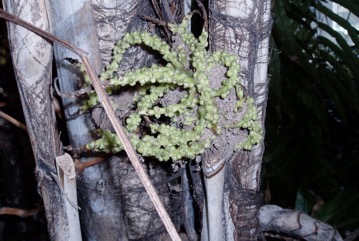
It grows in tropical and subtropical places. It can grow in warm temperate regions. It requires a rich well-drained soil. It needs regular moisture and humidity. It can grow in full or part sun. They are found wild in forests near streams at low altitudes in the Province of Palawan in the Philippines. It can grow in arid places. In Indonesia it grows up to 1,500 m above sea level. It suits hardiness zones 10-12. Adelaide Botanical Gardens. Mt Cootha Botanical Gardens.
Also known as:
Ansae, Beredin, Burmese Fishtail palm, Chongsae, Cluster fishtail palm, Dudok, Dung dinh, Fishtail Palm, Genduru, Khen ang mu, Khidir, Mari patti, Mari supari, Mei-hle, Meredin, Minbaw, Mudor, Palem sarai, Pugahang-suwi, Rabok, Sarai, Tamibaw, Tao rang, Tukas, Tukus, Tunsae, Wijnpalm
Synonyms
- Caryota furfuracea Blume
- Caryota griffithii Beccari
- Caryota griffithii var. selebica Becc.
- Caryota javanica Zipp. ex Miq. [Illegitimate]
- Caryota nana Linden
- Caryota propinqua Blume ex Mart.
- Caryota sobolifera Wallich
- Caryota speciosa Linden
- Drymophloeus zippellii Hassk.
- Thuessinkia speciosa Miq.
Edible Portion
- Seeds, Cabbage, Starch, Sago, Palm heart, Sap
Where does Lesser fishtail palm grow?
Found in: Africa, Asia, Andamans, Australia, Brunei, Burkina Faso, Cambodia, Caribbean, China, East Africa, Egypt, Fiji, Guatemala, Guianas, Haiti, Hawaii, India, Indochina, Indonesia, Kenya, Laos, Madagascar, Malaysia, Mayotte, Myanmar, North Africa, North America, Northeastern India, Pacific, Philippines, Puerto Rico, SE Asia, Singapore, Slovenia, Sri Lanka, Suriname, Tanzania, Thailand, United States, Vietnam, West Africa
Notes: There are 12 Caryota species. They are tropical.
Growing Lesser fishtail palm, Clustered fishtail palm
Cultivation: Plants can be grown from seed or by division of the suckers. Seed usually take 4-6 months to germinate. Plants respond to nitrogen fertiliser. Plants tolerate full sun when small.
Edible Uses: The bud is cooked and eaten. It is slightly bitter. The fruit is poisonous but the seeds are edible. Edible starch can be extracted from the stem. Sap is extracted from the flowering stem and used for sugar or wine.
Production: Plants are fast growing.
Nutrition Info
per 100g edible portion| Edible Part | Energy (kcal) | Protein (g) | Iron (mg) | Vitamin A (ug) | Vitamin c (mg) | Zinc (mg) | % Water |
|---|---|---|---|---|---|---|---|
| Seed | - | - | - | - | - | - | |
| Stem starch | - | - | - | - | - | - | |
| Palm heart | - | - | - | - | - | - |
Lesser fishtail palm, Clustered fishtail palm Photos

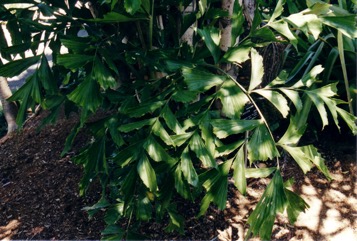
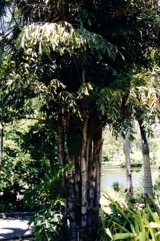
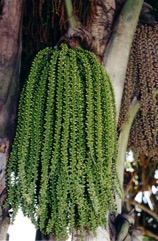
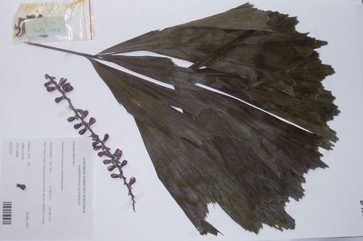
References
Ambasta S.P. (Ed.), 2000, The Useful Plants of India. CSIR India. p 108
Anderson, E. F., 1993, Plants and people of the Golden Triangle. Dioscorides Press. p 205
Arora, K., Indigenous Forest Management in the Andaman and Nicobar Islands, India.
Awasthi, A.K., 1991, Ethnobotanical studies of the Negrito Islanders of Andaman Islands, India - The Great Andamanese. Economic Botany 45(2) pp 274-280.
Balick, M.J. and Beck, H.T., (Ed.), 1990, Useful palms of the World. A Synoptic Bibliography. Colombia p 216, 426, 597, 659,
Bhargava, N., 1983, Ethnobotanical Studies of the Tribes of Andaman and Nicobar Islands, India. 1. Onge. Economic Botany 37(1): 110-119
Blomberry, A. & Rodd, T., 1982, Palms. An informative practical guide. Angus & Robertson. p 72
Blomberry, A. & Rodd, T., 1982, Palms. An informative practical guide. Angus & Robertson. p 72
Bodkin, F., 1991, Encyclopedia Botanica. Cornstalk publishing, p 219
Brickell, C. (Ed.), 1999, The Royal Horticultural Society A-Z Encyclopedia of Garden Plants. Convent Garden Books. p 233
Burkill, I.H., 1966, A Dictionary of the Economic Products of the Malay Peninsula. Ministry of Agriculture and Cooperatives, Kuala Lumpur, Malaysia. Vol 1 (A-H) p 476
Chai, P. P. K. (Ed), et al, 2000, A checklist of Flora, Fauna, Food and Medicinal Plants. Lanjak Entimau Wildlife Sanctuary, Sarawak. Forestry Malaysia & ITTO. p 163
Checklist of NT Vascular Plant Species. January 2003.
Cundall, P., (ed.), 2004, Gardening Australia: flora: the gardener's bible. ABC Books. p 336
Dharani, N., 2002, Field Guide to common Trees & Shrubs of East Africa. Struik. p 285
Dobriyal, M. J. R. & Dobriyal, R., 2014, Non Wood Forest Produce an Option for Ethnic Food and Nutritional Security in India. Int. J. of Usuf. Mngt. 15(1):17-37
Eiadthong, W., et al, 2010, Management of the Emerald Triangle Protected Forests Complex. Botanical Consultant Technical Report. p 23
Engel, D.H., & Phummai, S., 2000, A Field Guide to Tropical Plants of Asia. Timber Press. p 74
Etherington, K., & Imwold, D., (Eds), 2001, Botanica's Trees & Shrubs. The illustrated A-Z of over 8500 trees and shrubs. Random House, Australia. p 186
Facciola, S., 1998, Cornucopia 2: a Source Book of Edible Plants. Kampong Publications, p 27
Fl. cochinch. 2:569. 1790
Gibbons, M., 1993, Palms. Compact study Guide and Identifier. Sandstone. p 24
Gibbons, M., 2003, A pocket guide to Palms. Chartwell Books. p 66
Haynes, J., & McLaughlin, J., 2000, Edible palms and Their Uses. University of Florida Fact sheet MCDE-00-50-1 p 4
Heywood, V.H., Brummitt, R.K., Culham, A., and Seberg, O., 2007, Flowering Plant Families of the World. Royal Botanical Gardens, Kew. p 348
Hibbert, M., 2002, The Aussie Plant Finder 2002, Florilegium. p 61
Hoare, A., 2003, Food use of the Lundayeh SW Sabah. Borneo Research Council.
Hu, Shiu-ying, 2005, Food Plants of China. The Chinese University Press. p 301
Jacquat, C., 1990, Plants from the Markets of Thailand. D.K. Book House p 108
Japanese International Research Centre for Agricultural Science www.jircas.affrc.go.jp/project/value_addition/Vegetables
Johnson, D.V., 1998, Tropical palms. Non-wood Forest products 10. FAO Rome. p 42, 46
Jones, D.L., 1994, Palms throughout the World. Smithtonian Institution, Washington. p 163
Jones, D.L., 2000, Palms of Australia 3rd edition. Reed/New Holland. p 131
Kar, A., et al, 2013, Wild Edible Plant Resources used by the Mizos of Mizoram, India. Kathmandu University Journal of Science, Engineering and Technology. Vol. 9, No. 1, July, 2013, 106-126
Llamas, K.A., 2003, Tropical Flowering Plants. Timber Press. p 97
Lord, E.E., & Willis, J.H., 1999, Shrubs and Trees for Australian gardens. Lothian. p 94
Martin, F.W. & Ruberte, R.M., 1979, Edible Leaves of the Tropics. Antillian College Press, Mayaguez, Puerto Rico. p 210
Menninger, E.A., 1977, Edible Nuts of the World. Horticultural Books. Florida p 131
Monsalud, M.R., Tongacan, A.L., Lopez, F.R., & Lagrimas, M.Q., 1966, Edible Wild Plants in Philippine Forests. Philippine Journal of Science. p 524
Ochse, J. J. et al, 1931, Vegetables of the Dutch East Indies. Asher reprint. p 559
Ogle, B. M., et al, 2003, Food, Feed or Medicine: The Multiple Functions of Edible Wild Plants in Vietnam. Economic Botany 57(1): 103-117
Plants of Haiti Smithsonian Institute http://botany.si.edu
PROSEA (Plant Resources of South East Asia) handbook, Volume 9, 1996, Non seed carbohydrates
Recher, P, 2001, Fruit Spirit Botanical Gardens Plant Index. www.nrg.com.au/~recher/ seedlist.html p 7
Riffle, R.L. & Craft, P., 2003, An Encyclopedia of Cultivated Palms. Timber Press. p 290
Royal Botanic Gardens, Kew (1999). Survey of Economic Plants for Arid and Semi-Arid Lands (SEPASAL) database. Published on the Internet; http://www.rbgkew.org.uk/ceb/sepasal/internet [Accessed 5th May 2011]
Sang, D. T., & Mizoue, K. O. N., 2012, Use of Edible Forest Plants among Indigenous Ethnic Minorities in Cat Tien Biosphere Reserve, Vietnam. Asian Journal of Biodiversity Vol. 3 (1), p 23-49 (As Canarium tramdenum)
Singh, H.B., Arora R.K.,1978, Wild edible Plants of India. Indian Council of Agricultural Research, New Delhi. p 81
Slik, F., www.asianplant.net
Smith, A.C., 1979, Flora Vitiensis Nova: A New flora of Fiji, Hawai Botanical Gardens, USA Vol 1 p 408
Staples, G.W. and Herbst, D.R., 2005, A tropical Garden Flora. Bishop Museum Press, Honolulu, Hawaii. p 618
Soepadmo, E., 1998, Plants. The Encyclopedia of Malaysia. Archipelago press. p 54
Sukarya, D. G., (Ed.) 2013, 3,500 Plant Species of the Botanic Gardens of Indonesia. LIPI p 767
Tanaka, Y. & Van Ke, N., 2007, Edible Wild Plants of Vietnam: The bountiful garden. Orchid books. p 35
Turreira Garcia, N., et al, 2017, Ethnobotanical knowledgeof the Kuy and Khmer people in Prey Lang, Cambodia. Cambodian Journal of Natural History 2017 (1): 76-101
Van Sam, H. et al, 2008, Uses and Conservation of Plant Species in a National Park. A case study of Ben En, Vietnam. Economic Botany 62:574-593
Wickens, G.E., 1995, Edible Nuts. FAO Non-wood forest products. FAO, Rome. p164
World Checklist of Useful Plant Species 2020. Royal Botanic Gardens, Kew